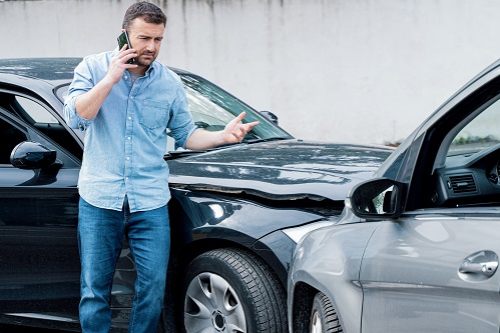How to shop for car insurance in 5 easy steps
Before shopping for car insurance there are a few things you should do to prepare. Be sure to have all the necessary documentation ahead of time, as well as relevant details about your vehicle.
Other information, such as your state's minimum levels of coverage and how much coverage you currently have, will also be important during the process.
Ready to get started? Here are the five steps to shopping for car insurance.
1. Gather all of the documents and information you need
There are some important documents you should have ready when shopping for a new car insurance policy. Having these handy will make the process smoother. Make sure you have:
- Driver’s license: Have everyone’s license handy to read off names, license numbers, and birth dates.
- Previous policy: If you have a previous policy, it will show your coverage limits, allowing you to compare quotes for the same coverage.
- Information about your lienholder. If your car is financed, you will need to provide the details to your insurance company.
2. Choose your coverage
There are several types of car insurance, some of which are required by law. Here is a quick breakdown of the most common types:
- Liability: There are two types of liability coverage, and both are required by law in nearly every state. Bodily injury liability pays for injuries to others when you are at fault in an accident. Property damage liability covers damage to the other driver’s vehicle when you are at fault.
- Comprehensive: Covers physical damages that don't involve a collision, such as weather damage or a collision with an animal.
- Collision: Covers damage to your vehicle from a collision with another vehicle or if you hit an object like a building or pole.
- Personal injury protection (PIP): Required by law in some states, PIP covers your medical bills and other costs, such as funeral expenses, regardless of who is at fault in the accident.
- Medical payments (MedPay): Also a no-fault coverage, MedPay pays medical costs for anyone involved in an accident.
- Uninsured/Underinsured motorist (UM/UIM): Covers you if you’re involved in an accident with someone who doesn’t have insurance or whose limits aren’t high enough to cover the damages. It’s required by law in some states.
Full coverage is a term used to describe a policy that includes all legally required coverages as well as comprehensive and collision. It’s the costliest policy to carry, and most states don't require quite so much coverage. However, it’s required if you are financing or leasing a vehicle.
There are a few other optional coverages you may want to consider, such as:
- Rental reimbursement. Pays for a rental car while your car is being repaired as part of a covered claim.
- Roadside assistance. Provides services such as help with a flat tire, jumping a dead battery, lockouts, and towing your vehicle if it breaks down.
3. Choose where to shop for car insurance
You have a few options regarding where to get car insurance. All have pros and cons, but it comes down to individual preference.
Buying insurance from an independent insurance broker
One option is to buy through an independent broker. This approach can be beneficial because brokers represent you and shop the entire market. You might have to pay a broker's fee if you go this route.
Brokers differ from agents in that they work for you, not for any insurance company, and can get quotes from any company.
Buying insurance from an insurance agent
There are two types of agents. Independent agents represent many insurance companies but don’t work directly for any company. They can help you compare rates from any of their contracted companies. Those companies may include large insurance companies as well as small, local companies.
Captive agents work solely for the one company they represent. For example, big insurers like State Farm and Allstate use captive agents. These agents will be very knowledgeable about policies for their insurers but can’t help you buy from any other company.
Buying insurance directly from an insurance website
Most insurance companies today sell policies directly online, including those that also use agents. Some sell exclusively online, cutting out the cost of agent commissions.
There are also insurance websites where you can shop and compare several companies at once and complete your policy purchase when you’ve decided. This makes comparison shopping quicker and easier but doesn’t offer the personal assistance of an agent.
4. Compare auto insurance quotes
As you look for quotes, you should compare the prices of the different types of polices being offered by different insurers. Using an online insurance-quote comparison platform is an easy way to do this. The platforms are designed to allow you to quickly compare quotes without the need to enter your information repeatedly on different sites.
How to use an insurance comparison site
Insurance comparison sites are a great way to get multiple quotes in one place. You will be asked to supply information such as your name, address, and age, as well as information about your vehicle. Once you have provided all the necessary information, you will see a list of quotes from several insurers, allowing you to compare quotes apples-to apples for the coverage you need.
How many quotes should you get?
Experts usually recommend getting prices from at least three insurers.
Comparing three to five will give you a good idea of what your options are without getting lost in a sea of car insurance quotes. However, the more you compare, the better your chances of finding a great deal.
5. Compare companies and buy your policy
The number one way to find the best deal on insurance is to shop around and compare rates from several companies, but make sure you are not only looking at price. Compare the companies on reputation and claims service, as well as financial standing. This will help you narrow down your choices.
From there you can choose the combination of price and service that meets your needs.
How can you get the lowest car insurance rates?
There are other ways to save on your car insurance, and when combined with rate comparisons, you can get much lower insurance rates.
Compare different deductibles. The deductibleThe deductible is the amount you pay out of pocket for a covered loss when you file a claim. is the amount you pay when you file a comprehensive or collision claimAn insurance claim is a request you make to your insurance company for coverage after your car is damaged or you have an accident. You can file a claim online, by phone, or in writing., and a higher deductible means lower rates.
Ask for discounts: Insurers may offer discounts for having a safe driving record, your car's safety features, or customer loyalty. Ask about discounts directly when buying a policy to find out whether you might be eligible for any of them.
Ask about bundles: One of the biggest discounts available is the bundling discount for buying more than one policy from the same company. The most common example is the bundling of car and home insurance together. Auto-home bundles can sometimes result in a 10% or more reduction in your insurance costs.
Why do you need car insurance?
You need car insurance for two main reasons: to protect yourself financially and comply with state law.
Car insurance is required by law in nearly every state. Even the states without mandatory insurance laws require you to be financially responsible in the event of an accident.
In a serious accident, costs can mount very quickly. Most people don’t have the financial means to cover the damages, which is why everyone needs insurance.
When should you shop for car insurance?
Generally, it’s a good idea to shop for car insurance every year, as car insurance rates can change over time. However, there are other times when you may want to shop around. For example, when you:
- Want to add a teen driver to your policy
- Move to a new state
- Buy a new car
- Have an accident or get a ticket
- Have a rate increase on your renewal
You might be surprised at the difference from one company to another, and by how much you could save.
What you need to know to get car insurance quotes
Some things to know before shopping for car insurance include information about any drivers on the policy, information about your car, and state minimums.
You’ll also need information about all drivers, including their driving records, and whether your cars are used to commute or for pleasure.
Vehicle type
The type of vehicle you drive has a big impact on your car insurance rates. Using the car’s VIN is the best way to provide the insurance company with all the details, but if you don’t know it, you should list the make, model, and trim level.
You may also need to provide the mileage and details about safety and security features, like an alarm system.
Your state's minimum required coverage
Most states require you to have at least liability coverage before you get behind the wheel. But each state sets its own coverage minimums. Some require other coverage, including no-fault coverages like PIP if you live in a no-fault state.
Your policy should have at least the minimum, but it’s wise to carry more. Most minimum car insurance policies don’t provide enough protection in an accident.
Driver details
To get accurate quotes, you will need to provide details of each driver's history, including any tickets or accidents. You'll also need to let the insurance company know how each driver uses the car, such as for commuting or only on weekends.
How to purchase a policy
If you already know what type of policy you want to buy, such as full coverage or comprehensive/collision, you can do so directly from an insurance website. For example, if you want to buy a policy from State Farm, you can head to the insurer's website, type in your ZIP code, and start your quote.
By this point, you should already have information such as VIN and license numbers, which you may need during the process. Also, some insurers offer many types of insurance. State Farm, for example, allows you to request a quote for auto plus renters insurance; bundling insurance can be cheaper than buying each type of insurance separately.
Generally, the best way to get the lowest car insurance rates is to use the methods discussed in earlier sections. Shopping around and asking for discounts will help you get the best rate. There are a few things to consider to save on car insurance.
TIP"Have a good driving record and a good credit score (depending on the State), don't purchase state minimums as this makes you less desirable when shopping (I call this the 'responsible adult discount'), and having your homeowners/renters with the same carrierAn insurance carrier is the company that provides your car insurance policy and pays claims.," says Ben Guttman, a broker at North Central Insurance Agency, an independent insurance agency.
Guttman calls out a couple of interesting tricks that could help lower your rate here. Having a good credit score makes you eligible for a lower rate in most states, although a few states have outlawed the practice of using credit scores for car insurance. A safe driving record and bundling your insurance also mean lower rates.
Ultimately, a combination of different factors contributes to your rates. Not all are in your control, but paying attention to the ones that are when shopping for car insurance can make a big difference.



